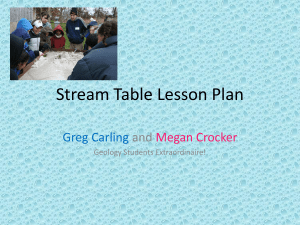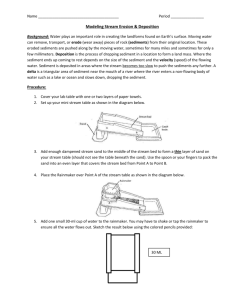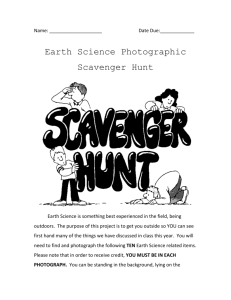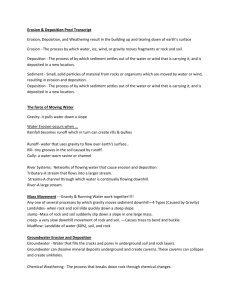bell_ringer_weathering_geohist_misc
advertisement
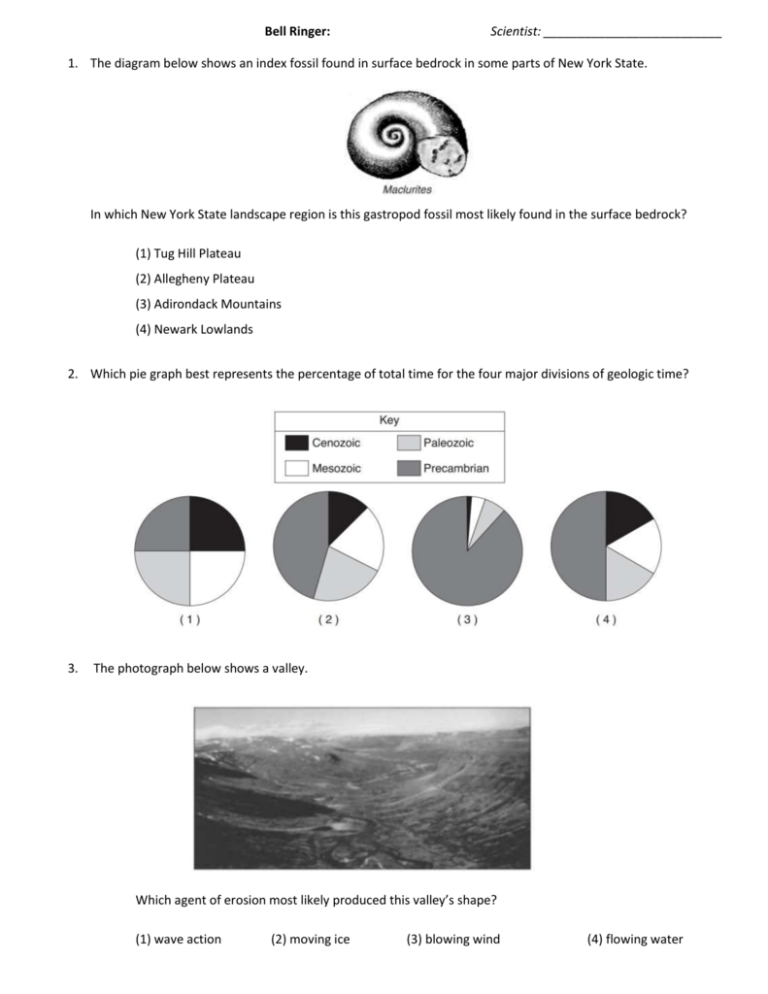
Bell Ringer: Scientist: __________________________ 1. The diagram below shows an index fossil found in surface bedrock in some parts of New York State. In which New York State landscape region is this gastropod fossil most likely found in the surface bedrock? (1) Tug Hill Plateau (2) Allegheny Plateau (3) Adirondack Mountains (4) Newark Lowlands 2. Which pie graph best represents the percentage of total time for the four major divisions of geologic time? 3. The photograph below shows a valley. Which agent of erosion most likely produced this valley’s shape? (1) wave action (2) moving ice (3) blowing wind (4) flowing water 4. Deposition within a meandering stream usually occurs on the inside of the curves because the (1) water velocity decreases (3) water is deeper (2) stream gradient increases (4) stream is narrower 5. The diagram below shows an outcrop of different layers of sandstone in a region receiving heavy rainfall. Which sandstone layer appears to be the least resistant to weathering? (1) A (2) B (3) C (4) D 6. The map below shows a meandering stream. Points A, B, C, and D represent locations along the stream bottom. At which location is the greatest amount of sediment most likely being deposited? (1) A (2) B (3) C (4) D Base your answers to questions __ through __ on the cross sections below, which show widely separated outcrops labeled I, II, and III. Index fossils are found in some of the rock layers in the three outcrops. In outcrop III, layers A, B, C, and Dare labeled. Line XY represents an unconformity. Line GH represents a fault. 7. Describe one characteristic necessary for a fossil to be classified as an index fossil. _________________________________________________________________________________________ 8. On outcrop II above, place the symbol for an unconformity between the two rock layers where the Silurian-age bedrock has been removed by erosion. a. b. On the outcrop in the photograph below, place the symbol for an unconformity between the two rock layers where the metamorphic bedrock has been removed by erosion. 9. List in order, from oldest to youngest, the relative age of the four rock layers, A, B, C, and D, fault GH, and unconformity XY shown in outcrop III. Base your answers to questions __ through __ on the diagram below. The arrows show the direction in which sediment is being transported along the shoreline. A barrier beach has formed, creating a lagoon (a shallow body of water in which sediments are deposited). The eroded headlands are composed of diorite bedrock. A groin has recently been constructed. Groins are wall-like structures built into the water perpendicular to the shoreline to trap beach sand. 10. The groin structure will change the pattern of deposition along the shoreline, causing the beach to become (1) wider on the western side of the groin (3) narrower on both sides of the groin (2) wider on the eastern side of the groin (4) wider on both sides of the groin 11. Which two minerals are most likely found in the beach sand that was eroded from the headlands? (1) quartz and olivine (3) potassium feldspar and biotite (2) plagioclase feldspar and amphibole (4) pyroxene and calcite 12. The sediments that have been deposited by streams flowing into the lagoon are most likely (1) sorted and layered (3) unsorted and layered (2) sorted and not layered (4) unsorted and not layered 13. Which event will most likely occur during a heavy rainfall? (1) Less sediment will be carried by the streams. (2) An increase in sea level will cause more sediments to be deposited along the shoreline. (3) The shoreline will experience a greater range in tides. (4) The discharge from the streams into the lagoon will increase. 14. The diagram below shows the surface features of a landscape. Based on the features shown, which erosional agent had the greatest effect on tree growth and the structures that humans have built on this landscape? (1) running water (2) moving ice (3) prevailing wind (4) mass movement 15. The diagram below shows some features in a cave. Which rock was chemically weathered by acidic groundwater to create the cave and its features? (1) calcite (2) basalt (3) quartzite (4) limestone 16. The photograph below shows a large boulder of metamorphic rock in a field in the Allegheny Plateau region of New York State. The boulder was most likely moved to this location by (1) glacial ice (2) prevailing wind (3) streamflow (4) volcanic action 17. The map below shows a meandering river. Points A and B are locations on the banks of the river. What are the dominant processes occurring at locations A and B? (1) deposition at location A; erosion at location B (3) deposition at both locations A and B (2) erosion at location A; deposition at location B (4) erosion at both locations A and B 18. The diagram below shows sand particles being moved by wind. At which Earth surface locations is this process usually the most dominant type of erosion? (1) deserts and beaches (3) glaciers and moraines (2) deltas and floodplains (4) mountain peaks and escarpments 19. The landscape diagram below shows a fan-shaped pattern of sediment deposits. The fan-shaped pattern of these sediments is most likely the result of deposition by (1) glacial ice (2) ocean waves (3) running water (4) prevailing winds Base your answers to questions __ through __ on the cross section below, which shows the bedrock of a portion of the Helderberg Escarpment, located in Thacher State Park near Albany, New York. The rock formations are identified by name. 20. Which formations appear to be the most resistant to weathering? (1) Esopus and Oriskany (3) Schoharie, and Marcellus and Hamilton (2) Onondaga and Coeymans (4) New Scotland, and Schenectady and Indian Ladder beds 21. What is the main factor that causes the bedrock to weather at different rates? (1) elevation above sea level (3) age of rock layers (2) mineral composition (4) environment of formation 22. The Manlius layer formed during the early Devonian Period. What type of fossils could possibly be found in the Manlius layer? (1) earliest birds (3) Tetragraptus (2) earliest reptiles (4) Ctenocrinus Base your answers to questions __ through __ on the photographs and news article below 23. Which agent of erosion is most likely responsible for the collapse of the granite profile? (1) running water (2) glacial ice (3) wave action (4) mass movement 24. The granite bedrock formed when (1) sediments were buried (3) magma cooled underground (2) a volcano erupted (4) limestone recrystallized 25. The rock of the Old Man of the Mountain most likely includes a mineral with a composition of (1) NaCl (2) SiO2 (3) FeS2 (4) PbS 26. What does granite bedrock found high on a mountaintop indicate? (1) The crust has been sinking. (3) A large amount of erosion has occurred. (2) Global temperatures have cooled. (4) Sea level has risen. 27. Which of the landscapes below shows the proper stream development pattern through the Hillslope and Coastal plain regions? 28. Four quartz samples of equal size and shape were placed in a stream. Which of the four quartz samples below has most likely been transported farthest in the stream? 29. The model shown below illustrates stream erosion between locations A and B in the stream. Placing a second block under location A will cause the stream’s velocity to (1) decrease and the rate of erosion to decrease (2) decrease and the rate of erosion to increase (3) increase and the rate of erosion to decrease (4) increase and the rate of erosion to increase Base your answers to questions __ through __ on the map and the stream data table below. The map represents a stream flowing into a lake. An arrow shows the direction of streamflow. Points A and B are locations at the edge of the stream. Line AB is a reference line across the stream surface. Line CD is a reference line along the lake bottom from the mouth of the stream into the lake. The data table gives the depth of the water and distance from point A, in feet, along line AB. 30. The profile of stream channel below line AB is shown below. A B Using the map and the data table, explain why the depth of water 20 feet from point A is different from the depth of water 20 feet from point B. [1] ___________________________________________________________________________________________ ___________________________________________________________________________________________ 31. The sediments being carried by the stream include clay, pebbles, sand, and silt. List these sediments in the most likely order of deposition from point C to point D. [1] Base your answers to questions __ through __ on the block diagram below, which represents the landscape features associated with a meandering stream. WX is the location of a cross section. Location A indicates a landscape feature. B 32. The landscape feature at location A is best described as (1) a sandbar (2) an escarpment (3) a delta (4) a floodplain (3) a floodplain (4) a sandbar 33. The landscape feature at location B is best described as (1) a delta (2) an oxbow lake 34. Which cross section best represents the shape of the stream bottom at WX? 35. Which particle of quartz shows evidence of being transported the farthest distance by the stream? Base your answers to questions __ through __ on maps A, B, and C below, which show evidence that much of New York State was once covered by a glacial ice sheet. Map A shows the location of the Finger Lakes Region. The boxed areas on map A were enlarged to create maps Band C. Map B shows a portion of a drumlin field near Oswego, New York. Map C shows the locations of glacial moraines and outwash plains on Long Island, New York. 36. The arrangement of the drumlins on map B indicates that a large ice sheet advanced across New York State in which compass direction? [1] From the __________________ toward the ________________ 37. The diagrams below represent three sediment samples labeled X, Y, and Z. These samples were collected from □ three locations marked with empty boxes ( ) on map C below. □ Write the letter of each sample in the correct box ( ) on map C below to indicate the location from which each sample was most likely collected. 38. The drawing below shows a glacial erratic found on the beach of the north shore of Long Island near the Harbor Hill moraine. This boulder is composed of one-billion-year-old gneiss. Which New York State landscape region has surface bedrock similar in age to this erratic? ___________________________________________________________________________________________ 39. The cross section below shows the sedimentary rock layers at Niagara Falls in western New York State. Which rock layer appears to be most resistant to be weathering and erosion? 40. F (1) Lockport dolostone (3) Grimsby sandstone (2) Rochester shale (4) Queenston shale 41. f WEATHERING, EROSION, DEPOSITION QUESTIONS Scientist: ________________________ 1. Sediment is deposited as a river enters a lake because the (1) velocity of the river decreases (2) force of gravity decreases (3) volume of water increases (4) slope of the river increases 2. Stream drainage patterns that develop in a landscape region are controlled mostly by (1) bedrock structure (2) precipitation amounts (3) nearness to a large body of water (4) air temperature variations 3. Lichens are usually the first organisms that appear in barren, rocky areas. They use rootlike structures to split bedrock into small fragments. Lichens also secrete acidic solutions that help break down rock. The cross sections below represent an area when lichens first appeared (time 1) and that same area hundreds of years later, after it was changed by lichens and exposed to air and water (time 2). The soil shown in time 2 was formed mainly by (1) compaction and cementing (3) faulting and tilting of rock strata (2) weathering and biological activity (4) mass movement and deposition of particles The diagram below represents a meandering stream. Point A represents a location within the meandering stream. Arrows represent the direction of stream flow. 4. Identify the name of the largest sediment particles that can be transported at point A when the stream’s velocity is 100 cm/s. [1] _______________________________________________________________________________ 5. Describe the relative changes in the stream velocity and the rate of erosion that will occur after 2 days of heavy rainfall. [1] __________________________________________________________________________________ 6. Explain why rock particles transported by the stream often become more rounded. [1] ___________________________________________________________________________________________ 7. The photograph below shows a sandstone butte in an arid region. Which agents of erosion are currently changing the appearance of this butte? (1) glaciers and mass movement (2) wave action and running water (3) wind and mass movement (4) running water and glaciers 8. Sediment is deposited in a river delta because the (1) velocity of the river decreases (2) force of gravity decreases (3) volume of the river increases (4) gradient of the river increases 9. The large waterfall at Niagara Falls, New York, was originally located at the Niagara Escarpment. Which term best describes an escarpment? (1) U-shaped valley (2) V-shaped valley (3) cliff (4) drumlin 10. Trees growing on the edge of a river’s meander are most likely to fall into the river due to (1) deposition on the inside of the meander (3) erosion on the inside of the meander (2) deposition on the outside of the meander (4) erosion on the outside of the meander 11. What is the approximate minimum stream velocity needed to keep a 6.4-cm-diameter particle in motion? (1) 10 cm/s (2) 50 cm/s (3) 100 cm/s (4) 200 cm/s Base your answers to questions ___ through ___ on the map below and on your knowledge of Earth science. The map shows a retreating valley glacier and the features that have formed because of the advance and retreat of the glacier. 12. Describe one piece of evidence likely to be found on the exposed bedrock surfaces that could indicate the direction this glacier moved. [1] ___________________________________________________________________________________________ ___________________________________________________________________________________________ 13. Describe one difference between the arrangement of sediment in the moraines and the arrangement of sediment in the outwash plain. [1] ___________________________________________________________________________________________ ___________________________________________________________________________________________ 14. Describe the most likely shape of the valley being formed due to erosion by this glacier. [1] ___________________________________________________________________________________________ 15. Explain why the glacial ice absorbs less solar radiation than the surrounding exposed bedrock and soil. [1] ___________________________________________________________________________________________ ___________________________________________________________________________________________ 16. The drawing below shows a glacial erratic found on the beach of the north shore of Long Island near the Harbor Hill moraine. This boulder is composed of one-billion-year-old gneiss. Which New York State landscape region has surface bedrock similar in age to this erratic? ___________________________________________________________________________________________ 17. The cross section below shows the sedimentary rock layers at Niagara Falls in western New York State. Which rock layer appears to be most resistant to be weathering and erosion? 18. (1) Lockport dolostone (3) Grimsby sandstone (2) Rochester shale (4) Queenston shale 19. The cross sections below show a three-stage sequence in the development of a glacial feature. Which glacial feature has formed by the end of stage 3? (1) kettle lake 20. (2) finger lake (3) drumlin (4) parallel scratches LANDSCAPE QUESTIONS 1. New York State landscape regions are identified and classified primarily by their (1) surface topography and bedrock structure (2) existing vegetation and type of weather (3) latitude and longitude (4) chemical weathering rate and nearness to large bodies of water 2. The Catskills landscape region is classified as a plateau primarily because the region has (1) V-shaped valleys (2) jagged hilltops (3) horizontal bedrock structure (4) folded metamorphic rock 3. Which cross section best represents a plateau landscape region? 4. Which cross section best represents a plateau landscape region? 5. The block diagrams below, labeled A, B, and C, show the relative elevation and rock structure of three different landscape regions. Which set correctly identifies the landscape region shown in each block diagram? (1) A–mountain, B–plateau, C–plain (3) A–plateau, B–mountain, C–plain (2) A–mountain, B–plain, C–plateau (4) A–plateau, B–plain, C–mountain 6. The map below shows a stream drainage pattern. Arrows show the direction of stream flow. On which landscape region did this drainage pattern most likely develop? 7. The map below shows coastal features of a portion of Long Island, New York. Point A represents a location on a landscape feature that resulted from wave action and longshore currents. On which landscape feature is point A located? (1) moraine (2) delta (3) barrier island (4) floodplain 10. The narrow, sandy, barrier islands in the ocean along the south coast of Long Island were deposited by (1) wind 18. (2) streams (3) glacial ice (4) wave action

